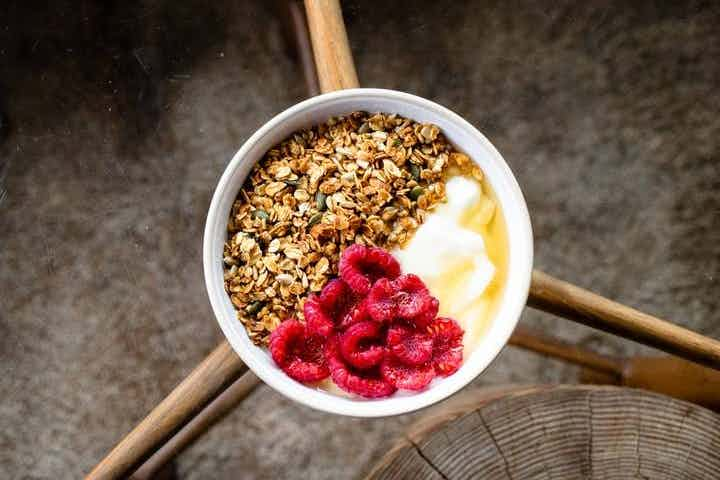Fibre is a crucial component of health that can help with digestion, gut health, and reducing your risk of certain diseases. According to this study, very few people in the UK get their recommended daily allowance. Only 9% of us manage it! Let’s look at six easy ways you can get more dietary fibre.
Frustrated with food waste or don't know where to start with a shopping list? Try a food subscription box to wash those worries away and put your diet - and finances - on the right track!
Why is fibre important?
The funny thing about fibre is that it is almost entirely undigestible. A bit like a Lego brick! You eat fibre; it travels through your digestive system and then leaves your body more or less wholly intact. Unlike a Lego brick, fibre does a lot of good while travelling through your body.
Fibre helps regulate your digestive system, helps you to have regular bowel movements, and reduces your risk of heart disease, strokes, bowel cancer. It can even reduce your risk of Type II diabetes. Another benefit of fibre is that it can help to improve your gut health by increasing good bacteria.
Not getting enough fibre can increase your risk of constipation and may increase your risk of developing the diseases mentioned above. An indirect benefit is that most foods that are high in fibre are also high in other nutrients.
High fibre foods are also highly satiating. This means if you eat a meal high in fibre, you will feel fuller for longer afterwards, thus reducing the likelihood of indulging in high-calorie foods between meals.
Thanks to the combination of satiety and gut health, high fibre diets are often associated with weight loss in people who were overweight to start with. Another benefit to consider!
Six easy ways to get more dietary fibre
The following six ways to increase your daily fibre intake are simple solutions that are easy to do and have multiple non-fibre related benefits. You don’t have to adopt all six at once. Try one or two at first and see how it goes.
Tip #1: Switch to whole wheat
The beauty of following this tip is that so little has to change. Pick up a different pack of pasta, swap out your regular rice for brown rice. Pick up a brown loaf of bread instead of a white one. Now, you don't need to ban all white bread, pasta, and rice from your diet, but swapping them once or twice per week for whole wheat could help increase your fibre intake.
Tip #2: Add an extra portion of veg to your evening meal
Vegetables are an excellent source of fibre, and they are versatile, cheap, and easy to cook. There are hundreds of ways to spice up bland vegetable dishes, so get creative in the kitchen! Turning meat and two veg into meat and three veg is an easy way to increase your daily fibre intake. Doing so will also provide more nutrients, filling you up more (less snacking) and making meat dishes last longer.
Tip #3: Experiment with beans and pulses
The UK is quite a way behind our European cousins when it comes to beans and pulses. Other than baked beans (a perfectly acceptable source of fibre, by the way), we don't tend to have a lot of dishes that use beans or pulses. In contrast, these are very common in French, Spanish, Portuguese, and Italian cuisine.
One benefit that we do have, though, is our ability to embrace foods from other cultures. Search for recipes in European, Asian, and African cookbooks, where beans and pulses are staples.
Becca Heyes from Easy Cheesy Vegetarian told Health Times: "Beans and lentils are a fantastic source of fibre, as well as being an important part of many vegetarian diets. Since they've not got a huge amount of flavour on their own, they're perfect for including in all sorts of cuisines - they're just as welcome in a British hotpot as they are in an Indian curry or a Tex-Mex burrito!
"Pulses are also packed with protein and iron, two more incredibly important nutrients, which vegetarians and vegans need to pay particular attention to."
Tip #4: Add fruit to your breakfast
Breakfast is often the meal with the least amount of effort put into it, which is understandable as it is usually performed in a daze before the sun has even risen. However, breakfast is an excellent opportunity to hit your fibre targets.
Sure, there is high-fibre cereal or whole wheat toast, but why not add in some fruit? It is easy to prepare, inexpensive, and provides vitamins and minerals. Fruit is an excellent source of fibre and a great way to kick your day off.
A good breakfast idea would be Greek yoghurt, rolled oats, and some berries mixed in a bowl. No cooking required, no real prep. Grab a bowl and a spoon. You will get fibre from the oats and the berries while getting your protein from the yoghurt.
Tip #5: Bring back the baked potato at lunch
Potatoes and sweet potatoes are excellent sources of fibre, particularly when you leave the skin on. But most potato dishes require you to peel them. That's why baked potatoes are such a fantastic lunch choice. Not only are they amazing when done properly (repeatedly stab with a fork, cover in salt and olive oil, place in the oven for 1 hour), you can combine them with multiple healthy fillings to create a different lunch each day.
Tip #6: Take fibre supplements
This last tip is a last resort. You should consider supplementing with fibre if you are struggling to hit your targets. But before taking them, try to achieve it through diet. This should be the same approach with vitamins and minerals and all other supplements.
But if you have consistently failed to get near your fibre targets and none of the tips in this article is likely to work, then a good fibre supplement can help.
What to do now
Now that you have read all six tips for increasing your dietary fibre, your first step should be to plan your next shopping trip. Check out recipes that incorporate more fruit, veg, beans and pulses. Look for some simple swaps you can do, like white bread for whole wheat bread, and make some changes to your main meals.
If you can find just one tip on this list that you can easily implement into your day, then you can count that as a success. Though hitting five or six would be even better!









